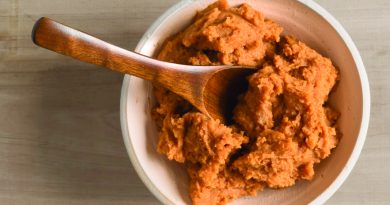Recipes, ideas for preserving your harvest
By Rebecca Mullins RHN
Want to enjoy locally grown produce year-round? Preserving the bounty you’ve grown or purchased from your farmers’ market or local food co-op makes this possible. Simple food preservation is a great way to extend our relatively short northern growing season. Preserving retains nutrients, flavour, texture and colour, and also saves money – but most importantly, you will know the food you’re eating and serving to your family.
Preserving may bring to mind rows of Mason jars filled with pickled beets and juicy peaches, and canning is making a wonderful comeback these days – but canning is just one way to preserve. Some other simple methods include freezing, dehydrating and fermenting – also pickling, jams/jellies, salt-curing and even “cellaring” (using an underground or partially underground space to store foods).
Freezing – most vegetables, fruits and herbs can easily be frozen for use all year long.
• Some veggies are best blanched and frozen shortly after harvesting
• Refrigerating first reduces freezing time, minimizing ice crystals
• Freeze prepared foods in a single layer on baking sheets, transferring to freezer bags once frozen – this keeps food from sticking together for easy measuring for recipes
Freezing Herbs
• Herbs like rosemary, thyme, dill and bay leaves freeze best left on stems – cut sprigs, spread on baking sheet, and place in freezer – once frozen, pack sprigs into freezer bags – to use: simply pick off leaves, and return unused sprigs to freezer bags
• Spoon whole or chopped herbs into ice cube trays, cover with a tiny bit of water, or blend with water and press into ice cube trays – remove when frozen, store in freezer bags
• Many herbs can be prepared as pesto – puree virtually any herb with olive oil in food processor – basil, parsley, oregano, cilantro, arugula, sage, garlic scapes and even dandelion greens, nettles and plantain – add garlic and/or nuts and/or grated cheese if desired – freeze as ice cubes, transfer into freezer bags once frozen
• Use in soups, stews, sauces, salad dressings and egg dishes like omelets and frittatas.
Dehydrating is an easy process for preparing vegetables, fruits, and even meats for long-term storage. Bacteria cannot grow when moisture is removed; foods stay delicious for months – even years! Purchasing a dehydrator is an option, but many recipes are possible using your oven.
• Provide good air circulation
• Don’t rush the process, partially dried foods won’t keep as long
• Dipping fruit slices in pineapple juice before dehydrating prevents browning – it’s delicious too!
Oven-Dried Tomatoes
Ingredients:
•Olive oil
•Fresh tomatoes (Romas are best)
•Sea salt
Directions:
Set oven to lowest setting. Slice tomatoes in half, remove seeds. Place cut-side up on greased baking sheet; lightly sprinkle with salt. Place in oven leaving door ajar for 6-10 hours until leathery but not brittle. Cool completely; store in air-tight container; shake daily.
Note: Enjoy tomatoes dried or rehydrated in hot water for soups, stews etc.
Fermented foods/beverages like yogurt, kefir, miso, tempeh and kombucha are becoming popular these days. Fermentation occurs when beneficial bacteria transform natural sugars in foods – the same bacteria that keep our immune and digestive systems healthy!
Simple Sauerkraut
Ingredients:
•1 cabbage, finely shredded
•2 teaspoons sea salt
Directions:
Gradually pack cabbage into a large food-grade container, tamping it down and sprinkling salt as you go. This forces water out of the cabbage creating the brine. Cover container, place clean weight on top to continually press down and force water out of cabbage and also to keep it submerged under brine. Cover entire container with towel. Check daily; the process will take 1-4 weeks – the longer, the tangier. Repack container each time you remove some, keeping remaining kraut submerged. (Consume “juice” as well – an unparalleled digestive tonic!)
Start new batch before current batch runs out – remove remaining kraut/juices from container, repeat above process, then pour remaining kraut/juices over new kraut, giving new batch an active culture starter.
Check out the National Center for Home Food Preservation – an excellent, up-to-date website providing information on all types of food preservation. http://nchfp.uga.edu/
Rebecca Mullins RHN is a registered holistic nutritionist in Northern Ontario, Canada.




